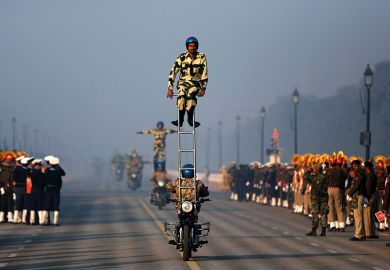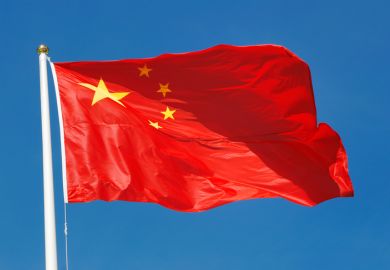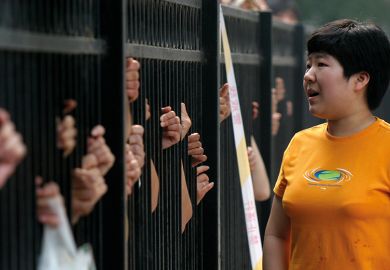Politicians and policy analysts like to make comparisons, and India and China are often set side by side. Both have large populations and are large land masses; both became “new” nation states about 70 years ago; both pursued five-year plans and maintained relatively closed economies until recently.
When it comes to higher education, however, the differences are stark and mostly the result of diverse strategies pursued by each nation over the past two decades to answer huge demand for tertiary education.
Both countries followed the Soviet model separating research and teaching and both maintained elite systems catering to 10 per cent of the youth population until the year 2000. They both also tended to focus their investments on STEM subjects.
One common comparative metric is the gross enrolment ratio (GER): the proportion of the youth population enrolled in tertiary education. In the year 2000 the ratios were roughly the same, India at about 10 per cent and China at 8 per cent. Then the ratio grew for both nations but at different rates. By 2005 China’s tertiary education GER was 19 per cent while India had edged up to 11 per cent. The gap persisted; by 2010 China had reached 24 per cent and India 17 per cent. Over the next five years the gap widened even further as China’s proportion of young people enrolled in tertiary education reached 46 per cent and India’s was 26 per cent.
Some of the difference in the country’s trajectories is attributable to different population policies. China’s one child per family policy meant that the youth population did not grow as rapidly as India’s.
But there were also differences in the supply of potential post-school students. This is illustrated by differences in adult (15 years or older) literacy rates. Since the 1980s China’s adult literacy rates usually have been at least 20 per cent higher than India’s adult literacy rate. This larger pool of educated youth and increased family aspirations for the one child fuelled demand for higher education in China.
At the same time the government of China was managing a shift to a market-oriented economy and dampened the flow of young people into the labour market by increasing tertiary education opportunities. The one child policy has also resulted in rapid accumulation of family wealth, with individuals benefiting from asset pooling from four grandparents and two parents. This supported greater consumption of services, such as post-school education.
Meanwhile in India, intergenerational transfer of wealth is more diffuse and less readily marshalled for investment in human capital.
Both nations increased the number of available student seats but in China most of the growth was in the public sector; even today enrolments at private institutions in China are modest. In India, private fee-charging institutions absorbed much of the increased demand.
There are other strategic differences. China began concentrating public resources, especially for research, on a limited number of universities – about 100 in the 211 programme which launched in 1995. In 1998, the 985 programme was even more tightly targeted towards 39 institutions. Both programmes signalled a shift away from independent research institutes and a desire to have world-class universities in China as quickly as possible.
While the specialist Indian institutes of technology, the Indian institutes of management and Indian institutes of science, education and research have benefited from differential public support for some time, the government’s recent Institutions of Eminence programme is a significant resource concentration strategy that aims to lift the research base of a small number of institutions. Yet, this initiative was launched more than 20 years after China’s university excellence programmes began.
Critics argue that resource concentration strategies create conflict between institutions that essentially have the same mission: to educate citizens and prepare a new generation of leaders. The government of China explicitly accepted that these differences would emerge and catered for them by creating special economic zones, such as Shenzhen, and by letting Shanghai re-emerge as the financial hub of the national economy. These regions were to be powerful dragons of development on the eastern coast. The western provinces were to benefit later.
China’s coastal cities have also opened up to foreign higher education providers after it joined the World Trade Organization in 2001. The number of international branch campuses grew from five in 1995 to about 35 today. Most of the students at these campuses are from local families.
India, on the other hand, continues to debate the role that foreign providers will play in its higher education system and has a long practice of building and buying locally as part of its basic economy policy.
Over the past two decades, India and China have responded to increased demand for higher education by making different strategic choices, in both the scale of public provision and setting up of regulatory frameworks. The economic outcomes have been profound. In 1987, the gross domestic product of both nations was about the same. By 2010, the Chinese economy was three times the size of India’s and it is now nearly five times larger.
This is not to belittle the achievements of India’s investments in its people. It has lifted 270 million out of poverty in the past 10 years and has worked to improve infrastructure and sanitation to benefit many and increase overall life expectancy. It has pursued a path of organic and balanced growth without the marked disparities between regions that characterises much of China’s growth.
Despite not keeping pace with China, India has a solid basis for significant and rapid improvement in higher education.
Alan Ruby is a senior fellow at the Alliance for Higher Education and Democracy in the University of Pennsylvania’s Graduate School of Education.
Mr Ruby will be speaking at the Times Higher Education India Universities Forum at Amity University, Noida, on 16-17 January 2020. Learn more.
Register to continue
Why register?
- Registration is free and only takes a moment
- Once registered, you can read 3 articles a month
- Sign up for our newsletter
Subscribe
Or subscribe for unlimited access to:
- Unlimited access to news, views, insights & reviews
- Digital editions
- Digital access to THE’s university and college rankings analysis
Already registered or a current subscriber? Login




